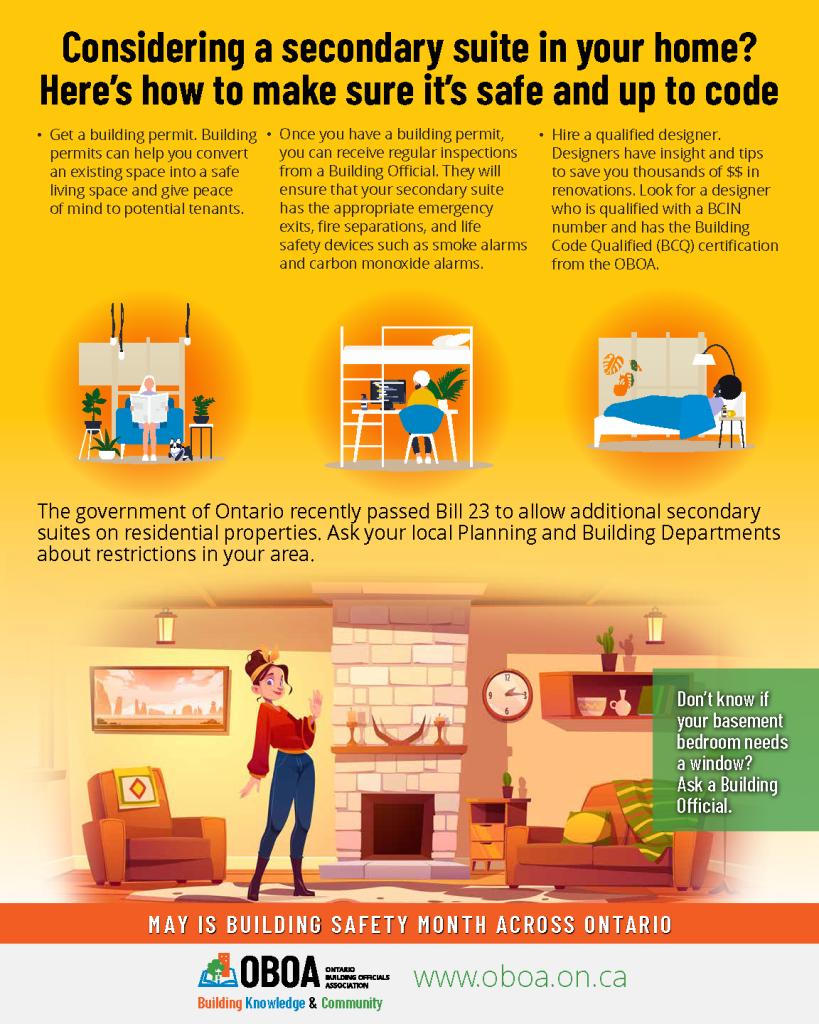A secondary dwelling unit is a dwelling unit located within and subordinate to an existing single detached, semi-detached, multiple attached or street multiple attached dwelling unit. It must have 2 or more rooms, provide an independent entrance, along with cooking and bathroom facilities.
Secondary units must meet the requirements of the City’s Zoning By-Law and obtain necessary approvals, such as a building permit and fire safety inspection.
Where are Secondary Dwelling Units Permitted?
- One secondary dwelling unit is permitted within a single detached dwelling in the following zones: UR1, UR2, UR3, UR4, UR5, SR1, RR1, RU1.
- One secondary dwelling unit is permitted within a semi-detached, multiple attached or street multiple attached dwelling unit in the following zones: UR2, UR3, UR4, UR5.
- Secondary dwelling units are not permitted in areas classified as ‘Natural Hazards.’ Please contact the Planning Department to determine if your property is located within a natural hazard area.
Requirements of the Zoning By-Law
- Secondary dwelling units must have a minimum gross floor area of 35 square metres (377 square feet)
- Within the UR1 Zone:
- The gross floor area of a secondary dwelling unit can’t be greater than 40% of the combined habitable room floor area of both units, with the exception that a secondary dwelling unit may occupy an entire basement.
- Exterior alterations to the front or exterior side yard elevations of the dwelling shall not be permitted to provide an entrance to a secondary dwelling unit.
- One parking space must be provided for each dwelling unit (parking spaces may be provided in tandem to a maximum of two spaces in a row). These spaces must be located entirely within the property limits and must meet the requirements of a parking space. Please see Section 3.37 of the Zoning By-Law or contact the Planning Department for further details on parking regulations.
Requirements of the Ontario Building Code
It is recommended that you obtain the services of a qualified professional such as an Architect, Engineer, or Designer registered with the Ontario government (BCIN Designer). The owner of the property is permitted by the Ontario Building Code to provide drawings for this type of application.
Building Code requirements should be reviewed prior to submitting a building permit application to avoid issues during the application or inspection process. Secondary Units that do not meet the OBC requirements cannot be approved. Building Code requirements to consider include, but are not limited to:
- Ceiling heights: The finished ceiling height, including the height under beams and ductwork, should be verified by the applicant and the height must be indicated on the plans.
- Laundry facilities: Must be located within each dwelling unit, or easily accessible by both dwelling units.
- Room size and floor size: All rooms must meet the minimum area specified by the OBC.
- Windows: Egress windows may be required. All windows must meet the minimum area required by the OBC for all rooms.
- Exits: Shared/separate entrance, fire rated, smoke/CO available?
- Age of the house
- Location of the second unit
- Plumbing and septic systems: Each dwelling unit must be equipped with a kitchen sink, and a bathroom that contains a bathtub or shower stall and a toilet.
- Heating and ventilation: Is the furnace shared? Is there adequate ventilation? Exhaust fans?
- Electricial facilities and lighting
- Fire safety, including fire separations and fire rated supporting assemblies
- Smoke alarms
- Sprinklers (if required)
- Carbon monoxide (CO) alarms
- Shared spaces
- Parking
A note regarding Bill 23, More Homes Built Faster Act, 2022:
Currently, a minor variance is required through the Committee of Adjustment to permit a secondary dwelling unit in an accessory structure. This will be in place until the Zoning By-Law is updated with regulations relating to Bill 23.
